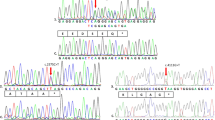Abstract
Transmission ratio distortion (TRD) is a property of complete t haplotypes which results in the preferential transmission of the t haplotype chromosome from heterozygous t/+ males to the majority of the offspring. A candidate gene for one of the primary genetic elements in TRD, the t complex responder locus has recently been suggested to be Tcp-10b t. There are multiple, functional Tcp-10 t genes, but genetic data suggest the presence of the Tcp-10a t gene alone is compatible with normal transmission ratios. Here we present the complete sequence and genomic structure of the Tcp-10a t gene which is compared with sequence data from a number of cDNAs and genomic subclones representing all active Tcp-10 t family genes. A detailed table of all sequence variants discovered in the course of our investigation is presented, and we have clarified the extent of 5′ untranslated alternative splicing patterns exhibited by this gene family. A 60 base pair (bp) in-frame deletion from the 5′ end of exon 3 of the Tcp-10a t gene is also presented and compared with the equivalent region of Tcp-10b t and Tcp-10c t. A search of the University of Edinburgh database has revealed a significant homology between the Tcp-10b t open reading frame and several cytosolic filament proteins. Interestingly, the region of homology is involved in the deletion from the Tcp-10a t gene.
Similar content being viewed by others
References
Axelrod, H.R., Artzt, K., and Bennett, D.: Rescue of embryonic cells homozygous for a lethal haplotype of the T/t complex: t w12. Dev Biol 86: 419–425, 1981.
Bullard, D.C. and Schimenti, J.C.: Molecular cloning and genetic mapping of the t-complex responder candidate gene family. Genetics 124: 957–966, 1990.
Cebra-Thomas, J.A., Decker, C.L., Snyder, L.C., Pilder, S.H., and Silver, L.M.: Allele- and haploid-specific product generated by alternative splicing from a mouse t-complex responder locus candidate. Nature 349: 239–241, 1991.
Collins, J.F. and Coulson, A.F.W.: Molecular sequence comparison and alignment. In: M. Bishop and C. Rawlings (eds.), Nucleic Acid and Protein Sequence Analysis: A Practical Approach, pp. 323–358, IRL Press, Oxford, 1986.
Fox, H.S., Martin, G.R., Lyon,M.F., Herrmann, B., Frischauf, A.-M., Lehrach, H., and Silver, L.M.: Molecular probes define different regions of the mouse t complex. Cell 40: 63–69, 1985.
Frischauf, A.-M.: The T/t complex of the mouse. Trends Genet 1: 100–103, 1985.
Hammerberg, C. and Klein, J.: Linkage disequilibrium between H-2 and t complexes in Chromosome 17 of the mouse. Nature 258: 296–299, 1975.
Henikoff, S.: Unidirectional digestion with exonuclease III creates targeted breakpoints for DNA sequencing. Gene 28: 351–359, 1984.
Herrman, B.G., Barlow, D.P., and Lehrach, H.: A large inverted duplication allows homologous recombination between chromosomes heterozygous for the proximal t-complex inversion. Cell 48: 813–825, 1987.
Hillman, N. and Nadijcka, M.: A study of spermatozoan defects in wild-type and T: t-bearing mice. J Embryol Exp Morph 44: 263–280, 1978.
Lyon, M.: Male sterility of the mouse t-complex is due to homozygosity of the distorter genes. Cell 44: 357–363, 1986.
Lyon, M.: Transmission ratio distortion in mouse t-haplotypes is due to multiple distorter genes acting on a responder locus. Cell 37: 621–628, 1984.
Lyon, M.F. and Mason, I.: Information on the nature of t-haplotypes from the interaction of mutant haplotypes in male fertility and segregation ratio. Genet Res 29: 255–266, 1977.
Olds-Clarke, P. and Peitz, B.: Fertility of sperm from t/+ mice: Evidence that +-bearing sperm are dysfunctional. Genet Res Camb 47: 49–52, 1985.
Rosen, L.L., Bullard, D.C., Silver, L.M., and Schimenti, J.C.: Molecular cloning of the t-complex responder genetic locus. Genomics 8: 134–140, 1990.
Saiki, R.K., Gelfand, D.H., Stoffel, S., Scharf, S.J., Higuchi, R., Horn, G.T., Mullis, K.B., and Erlich, H.A.: Primer Directed Enzymatic amplification of DNA with a thermostable DNA polymerase. Science 239: 487–491, 1988.
Sanger, F., Nicklen, S., and Coulson, A.R.: DNA sequencing with chain-terminating inhibitors. Proc Natl Acad Sci USA 74: 5463–5467, 1977.
Schimenti, J.C., Cebra-Thomas, J.A., Decker, C.L., Islam, S.D., Pilder, S. and Silver, L.M.: A candidate gene family for the mouse t complex responder (Tcr) locus responsible for haploid effects on sperm function. Cell 55:71–78, 1988.
Schimenti, J.C., Vold, L., Socolow, D., and Silver, L.M.: An unstable family of large DNA elements in the center of the mouse t complex. J Mol Biol 194: 583–594, 1987.
Silver, L.M. and Olds-Clarke, P.: Transmission ratio distortion of mouse t haplotypes is not a consequence of wild-type sperm degeneration. Devel Biol 105: 250–252, 1984.
Silver, L.M.: Mouse t haplotypes. Ann Rev Genet 19: 179–208, 1985.
Silver, L.M. and Remis, D.: Five of the nine genetically defined regions of mouse t haplotypes are involved in transmission ratio distortion. Genet Res Camb 49: 51–56, 1987.
Steinert, P.M., Rice, R.H., Roop, D.R., Trus, B.L., and Steven, A.C.: Complete amino acid sequence of a mouse epidermal keratin subunit and implications for the structure of intermediate filaments. Nature 302: 794–800, 1983.
Willison, K.R. and Ashworth, A.: Mammalian spermatogenic gene expression. Trends Genet 3: 351–355, 1987.
Author information
Authors and Affiliations
Rights and permissions
About this article
Cite this article
Davies, P.O., Willison, K.R. Sequence of the t complex Tcp-10a t gene and examination of the Tcp-10 t gene family. Mammalian Genome 1, 235–241 (1991). https://doi.org/10.1007/BF00352330
Received:
Accepted:
Issue Date:
DOI: https://doi.org/10.1007/BF00352330




